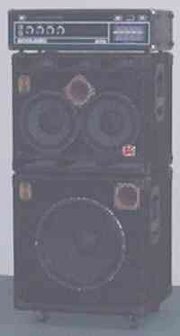Instrument amplifier
|
|
This page is about amplifiers for musical instruments. See also instrumentation amplifier, a type of operational amplifier.
Amphead.jpg
An instrument amplifier is an electronic amplifier designed for use with an electric or electronic musical instrument, such as an electric guitar.
| Contents |
Most common forms
Instrument amplifiers come in two main forms. The combo amplifier contains both the amplifier and suitable loudspeakers in a single unit. In the other form, the amplifier is separate from the loudspeakers, and joined to them by cables. The separate amplifier is called an amplifier head and is commonly placed on top of one or more loudspeaker enclosures, the amplifier head and loudspeaker enclosures together forming an amplifier stack.
An amplifier stack consisting of a head and one cabinet is usually called a half stack, while a head and two cabinets is a full stack.
History
The first instrument amplifiers were guitar amplifiers designed for use with electric guitars. Traditional guitar amplifiers provided a great deal of treble boost, and no high treble or low bass response at all. Some better models also provided a spring reverb and/or an electronic tremolo unit which electric guitarists (following the lead of the Fender company) have confusingly always called vibrato (and similarly they call a device designed to produce real vibrato a tremolo arm, see electric guitar, tremolo).
In the 1960s guitarists experimented with distortion produced by deliberately overloading (or overdriving) their amplifiers. The Kinks guitarist Dave Davies was quoted as saying "you just turn it up and it sounds like that, s'loovly". At one stage Davies was producing distortion by connecting the output of one amplifier into the input of another, an abuse which the designers could never have imagined (but see Maton).
Later, many guitar amplifiers were provided with distortion controls, and fuzz boxes and other effects pedals were engineered to safely and reliably produce these sounds. Today distortion is an accepted part of nearly all styles of electric guitar playing.
Guitar amplifiers were at first used with limited success with bass guitars and electronic keyboards, but it was quickly recognised that other instruments had different requirements than the electric guitar.
Present day
A wide range of instrument amplifiers is now available, some general purpose and some designed for specific instruments and even for particular sounds. These include:
- Traditional guitar amplifiers, with a clean undistorted sound, a sharp treble roll off at 5KHz or less and bass roll off at 60-100Hz, and often built-in reverb and "vibrato" units.
- Rock-style guitar amplifiers, intended for distortion.
- Bass amplifiers, with extended bass response and tone controls optimised for bass guitars.
- Keyboard amplifiers, with very low distortion and extended, flat frequency response in both directions.
- Acoustic amplifiers, similar in many ways to keyboard amplifiers but designed specifically to produce an "acoustic" sound when used with acoustic instruments with built-in pickups. (Note that there was once also a brand of guitar and bass amplifier called Acoustic, still seen second-hand.)
Some amplifiers are designed to fill more than one of these roles, and may have multiple inputs.
Some also have a microphone input. Guitar amplifier inputs typically have an impedance of about 1 Meg ohm, which is not ideal for use with low-impedance (typically 600 Ω)microphones. When a low-impedance input is provided this will generally be a balanced input and easily identified because it will use an XLR connector. Phantom power is not often provided, restricting the choice of microphones for use with these inputs.
Less common forms
Traditionally, an instrument amplifier provides sufficient gain to connect the instrument directly to its input, and sufficient power to connect loudspeakers directly to its output, both without requiring extra amplification. But other forms are possible.
Another arrangement, used more often for public address amplifiers, is to provide two stages of amplification in separate units. First a preamplifier or mixer is used to boost the instrument output, normally to line level, and perhaps to mix signals from several instruments. The output from this preamplifier is then connected to the input of a power amplifier, which powers the loudspeakers.
The preamplifier and power amplifier in this arrangement are often mounted together in a rack case. This case may be either free-standing or placed on top of a loudspeaker. If many rack-mounted effects are used, the rack may be a large unit on wheels. Some touring players need several racks just of effects units to reproduce on stage the sounds they have produced in the studio.
On the other extreme, if a small rack case containing both preamplifier and power amplifier is placed on top of a loudspeaker, the distinction between this arrangement and a traditional amplifier head begins to blur.
Another variation is to combine the power amplifier with the loudspeakers, which are then called powered speakers, and to use these with a separate preamplifier, sometimes combined into a pedal board.
Preamplifiers are also used to connect very low output instruments to instrument amplifiers.
Some major instrument amplifier manufacturers (alphabetical)
- Acoustic
- AER
- Alesis
- Ampeg
- Ashdown Engineering
- Bad Cat
- Behringer
- Bogner
- Carvin A&I
- Cordford
- Crate
- Electrovoice
- Engl
- Fender
- Framus
- Hartke
- Hiwatt
- Hoffman
- Hughes & Kettner
- Ibanez
- Korg
- Laney Amplification
- Line6
- Marshall
- Matchless
- Mesa/Boogie
- Orange
- Peavey
- Rivera
- Roland
- Ross
- Soldano
- SWR
- Tech 21
- Trace Elliot
- Vox
- Yamaha
External link
- Duncan's amp pages (http://www.duncanamps.com/index.htm) - all sorts of information, especially but not only on valve guitar amplifiersde:Gitarrenverstärker


